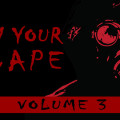Playing 999: Nine Hours, Nine Persons, Nine Doors Again — The Nonary Games Edition

The original version of visual novel 999: Nine Hours, Nine Persons, Nine Doors was a sleeper hit when it released late in the Nintendo DS’ life in 2010, particularly in America. Aksys Games took a risk when they published it, since visual novels of this type weren’t often localized. But the risk paid off when the game sold so well out the gate that Aksys needed to request two more initial printings to keep it stocked in stores. The game’s popularity contributed to a desire from publishers to localize more visual novels for a variety of platforms, alongside titles like Capcom’s Ace Attorney series.
But Spike Chunsoft also wanted to keep this game around and port it to other platforms, which they couldn’t do with the DS version thanks to its unique dual-screened setup. This led to the existence of Zero Escape: The Nonary Games, which included a single-screened version of the original game and a port of sequel Zero Escape: Virtue’s Last Reward. I mainly purchased the package to play through the latter game, but before getting into that, I wanted to see how good a job they did adapting 999 to one screen. Several aspects of it depended on the dual-screened setup, after all. It was also a good opportunity to reexperience the game in general, given that it had been eight years since I played it.

The new presentation seems perfectly palatable early in the game, when protagonist Junpei has to make his way out of the first puzzle room after awaking. I played this on PlayStation 4, which is reliant on moving a cursor to examine parts of the environment and pick up items. It was easier to simply tap them on a touchscreen to do this, but this change merely took some adjusting. (It also would have been nice to click them, too, which makes the PC version sound enticing.)
But it doesn’t take long for the new presentation to get odd. Instead of one screen being for dialogue between characters and another for narration, the game includes the option to switch between “ADV” and “Novel” presentations. Neither is perfect, since the former gets rid of the narration entirely, getting rid of the descriptions of rooms, facial emotions, and certain actions thanks to the 2D presentation. The Novel option works better for seeing all the text, even though it often covers the animated portraits. It gets humorous when the game locks you to a certain view during certain story sections, which especially happens in later parts of the game.

This isn’t me saying I outright prefer the DS version, since the Nonary Games edition has its benefits. It’s nice to play this game on the big screen instead of two smaller ones, and the art style transitioned to HD well outside some 3D aspects. I also appreciated the addition of voice acting, which is well done. Nearly everything is accompanied by voicework, including all of Junpei’s normal speaking parts and inner monologue. (Sequel Virtue’s Last Reward’s protagonist is unvoiced.) The only aspects that aren’t voice acted include select dialogue in the puzzle rooms (story-related matters do have voice acting while in them), and the narration.
The story is still as good as I remembered, which is full of as many twists and turns as you might expect from a visual novel. The game has several paths to take, all of which include different story developments and endings, making them all worth playing. Some twists have been slightly altered thanks to the single-screen presentation, and a key one received a big change that’s not as clever, but it doesn’t detract from the overall experience.
I didn’t remember the solutions to most puzzles after so much time passed, so solving them again was enjoyable. 999’s puzzles are deceptively difficult in how they seem obtuse ostensibly, but they’re the kind you’ll (figuratively) hit yourself over after realizing the solutions were actually simple.

The Nonary Games version of 999 also inherits a key feature from the mobile adaptation and its progeny in having a flowchart. The biggest complaint from the original DS version involved having to replay the game over and over again to obtain each ending. This wasn’t an issue with the dialogue sequences since they could be sped through, but the need to redo the puzzles each time was annoying. But there’s little need to do that when you can jump from one section to another with the flowchart, which makes it quicker to play through and easier to keep track of which paths you haven’t explored. Note the use of “little need,” because it’s sometimes necessary to replay earlier puzzle rooms so the story will go down a different path on the flowchart. But this is nowhere near as frequent as the DS version.
It’s not easy to play the original version these days, with the game and system being out of print. So, this version is the best way to play it at a good price. It’s clear they took some liberties with adapting the game to a more traditional format, but most of the experience is still intact. It’s a perfectly fine way to play or replay it.
Now, it’s time for me to finally play Virtue’s Last Reward after all these years.





